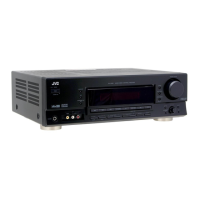Basic Operations
The following operations are commonly used when you play any sound sources.
L___J L_____J
1 Turn on the power.
• See "Turning On the Power" below.
2 Select the source.
• See "Selecting the Source to Play" to the right.
3 Adjust the volume.
• See "Adjusting the Volume" on page 10.
4 Select the Surround or DSP modes.
• See "Activating the Surround Modes" (page 25) and
"Activating the DSP Modes" (page 27).
When you have connected digital source components using the
digital terminals, first change the input mode for these components
to the digital input mode (see page l l).
o° I I o°
Press one of the source selection buttons.
ANALOG
[] []
Selected source name appears.
I/ L..
VOLUME
II
I...... !
L_____/ L____J
Press STANDBY/ON r3/I (or STANDBY/ON Otl AUDIO on
the remote control).
The STANDBY lamp goes off.
ANALOG
[] []
Current source name appears.
[rz ,, -'1
..... il .£,1
Current volume level appears.
To turn off the power (into standby mode),
press STANDBY/ON (!)/I (or STANDBY/ON 0/I AUDIO on the
remote control) again.
The STANDBY lamp lights up.
Note:
A small amount of power is consumed in standby mode. To turn off
the power completely, unplug the AC power cord.
SOURCENAUE
On the front panel
TAPE/CDR CD DVD AUX
0000
FM/AM TV SOUND VOR
000
On the remote control
Notes:
• When connecting a CD recorder to the TAPE/CDRjacks, change
the source name shown on the display, For details, see page 12.
By pressing the one of the audio source selection buttons--TAPE/
CDR, CD, and FM/AM--on the remote control, you can turn on the
receiver and select the audio source.
9

